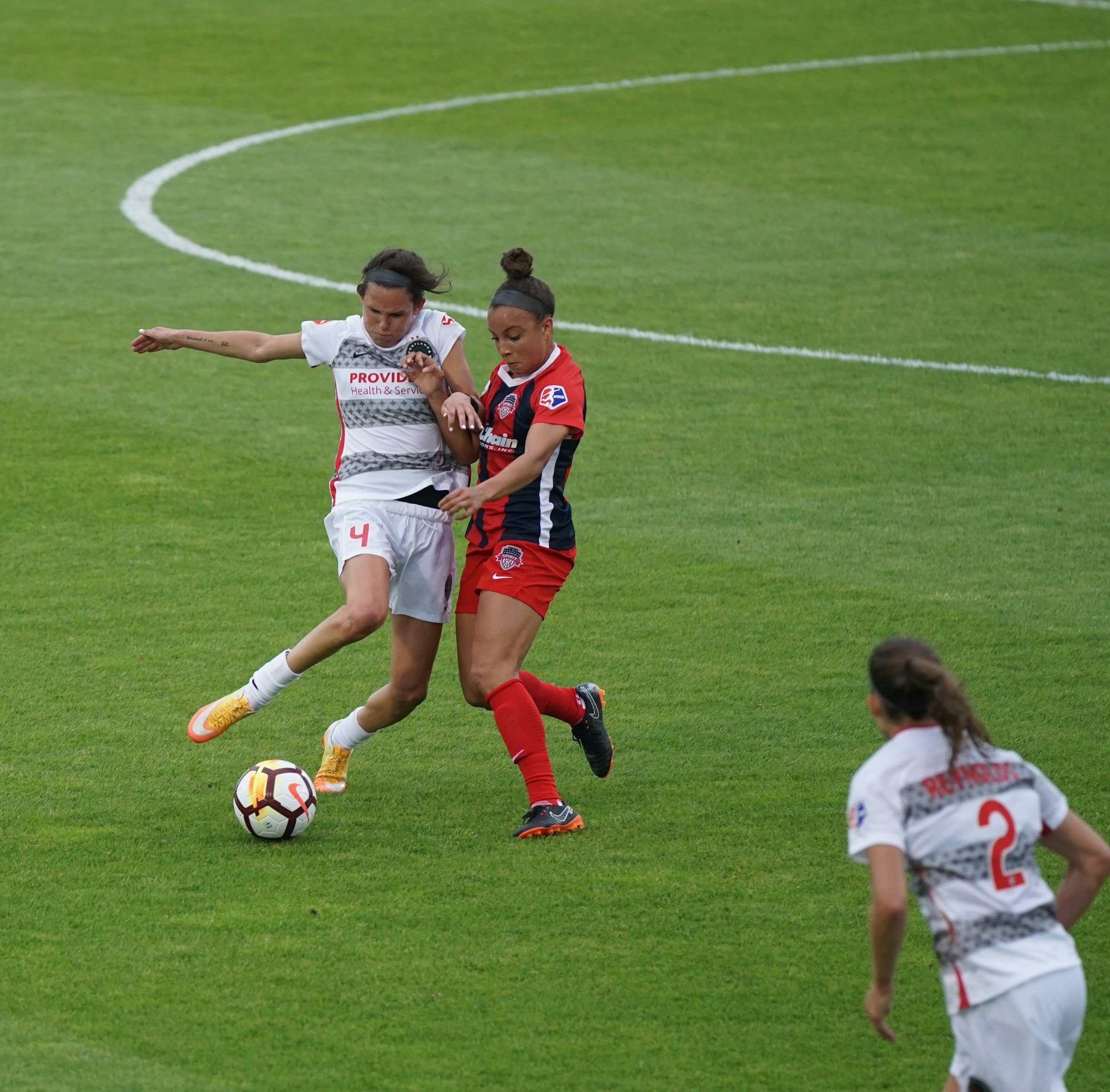Looking for a specific women’s football research topic?

Analysis of attacking styles and goal-scoring in the 2021/22 Women’s Super League
This research looked at how different ways of attacking led to shots on goal in the 2021/22 Women's Super League (WSL). The study analyzed 1179 attacking sequences from all 12 teams, categorizing each attack into styles like combinative organized attacks, fast organized attacks, direct organized attacks, counterattacks, and set plays.

Career patterns within men’s and women’s soccer talent systems: the typical pathway to the top is atypical
This study examines career pathways in women's soccer, challenging the traditional belief that early recruitment into professional academies guarantees future elite success. Researchers analyzed nearly 3,000 Dutch male and female youth players and found that only around 10% of those recruited into academies reached elite senior soccer.

Equal Pass: Comparing Passing Networks of England’s Top Women’s and Men’s Football Leagues
This study compares passing networks in England’s top women’s and men’s football leagues using social network analysis. Researchers analyzed 328 FA Women’s Super League matches and 760 English Premier League matches, focusing on metrics such as passing density, team connectivity, and player influence.

The Effect of Pitch Surface on Match Running Performance in Women’s Soccer
This study examined how playing on artificial turf (AT) versus natural grass (NG) affects match running performance in elite women’s soccer. Researchers analyzed data from 22 matches in the Slovenian Women’s First League, tracking total distance covered (TD), high-intensity running (HIR), accelerations (HIA), and decelerations (HID).

Seasonal Changes in the Physical Performance of Elite Youth Female Soccer Players
This study examined how the physical performance of elite youth female soccer players changed over a season. Researchers tracked 113 players (ages U10 to U16) and measured their speed, strength, power, change of direction (CoD), and aerobic fitness at three points during the season (pre-, mid-, and post-season).

Analysis of running performance in the two main Spanish Women’s football leagues: A case study
This study analyzed the running performance of players in Spain’s top two women’s football leagues, focusing on training sessions and match demands. Data from 32 players over two seasons revealed that competition matches required significantly higher physical effort than training sessions, with only the post-match session (MD+1) occasionally surpassing match demands in sprinting and high-speed running.

Optimizing Scanning in Youth Female Football: The Role of Verbal Instructions
The article "Optimizing Scanning in Youth Female Football: The Role of Verbal Instructions" examines how verbal instructions can improve visual exploration skills in young female soccer players. The study involved 25 elite U19 players who participated in small-sided games (4v4) under two conditions—one with verbal scanning prompts and one without.

Better the Devil You Know: Managers’ Networks, Hiring Decisions and Team Performance
The article "Better the Devil You Know: Managers’ Networks, Hiring Decisions, and Team Performance" examines how managers in professional football use their personal networks to make hiring decisions and how this impacts team performance. By analyzing data from both men’s and women’s football, the study finds that managers are significantly more likely to recruit players they have previously worked with, particularly for lower-cost, non-star players.

Effectiveness of an Exercise Protocol for Dynamic Balance in Amateur Female Soccer Players: A Randomized Clinical Trial
The article "Effectiveness of an Exercise Protocol for Dynamic Balance in Amateur Female Soccer Players: A Randomized Clinical Trial" examines how a structured balance training program impacts the stability and injury prevention of young female soccer players. Over six weeks, 24 amateur players were divided into an experimental group, which followed a dynamic balance exercise program, and a control group, which continued regular training.

Goal and shot prediction in ball possessions in FIFA Women's World Cup 2023: a machine learning approach
The article "Goal and Shot Prediction in Ball Possessions in FIFA Women’s World Cup 2023: A Machine Learning Approach" explores the use of machine learning to predict goal-scoring opportunities in elite women’s football. Researchers analyzed 2,346 ball possessions and developed predictive models using Random Forest and XGBoost techniques.

Technical-tactical evolution of women’s football: a comparative analysis of ball possessions in the FIFA Women’s World Cup France 2019 and Australia & New Zealand 2023
The article "Technical-Tactical Evolution of Women’s Football: A Comparative Analysis of Ball Possessions in the FIFA Women’s World Cup France 2019 and Australia & New Zealand 2023" examines how women’s football has evolved in terms of ball possession and game control. By analyzing 4,669 ball possessions from both tournaments, the study identifies significant increases in possession time, passing accuracy, and structured team play.

The “cost of football”: motherhood, coaching and work-family conflict
The article "The Cost of Football: Motherhood, Coaching, and Work-Family Conflict" by Isabel Martin and Ali Bowes examines the struggles faced by professional female football coaches who are also mothers. Through interviews with four full-time coaches in England, the study highlights the challenges of balancing a coaching career with motherhood.

Team resilience in high-performance women’s football: Contextual stressors and opportunities for development
The study explores team resilience in high-performance women’s football, identifying key stressors, effective resilience practices, and gaps in development. Through focus groups and expert consultations, researchers found that teams face both organizational and on-pitch challenges.

Linear and Multidirectional Speed Testing (On-Field and Off-Field) Protocols in Senior and Elite Female Football
The article "Linear and Multidirectional Speed Testing (On-Field and Off-Field) Protocols in Senior and Elite Female Football" provides a comprehensive review of current methods used to evaluate speed and agility in female soccer players. It highlights the distinct physiological and biomechanical demands of women's soccer, emphasizing the importance of tailored speed testing for both linear and multidirectional movements.

On Your Mark, Get Set, Choose! A Randomized Cross-Over Study Comparing Fixed and Self-Selected Rest Periods in Interval Running Among Professional Female Soccer Players
The article investigates the effects of self-selected (SS) versus fixed rest periods during high-intensity interval training (HIIT). The study compared performance, physiological responses (e.g., heart rate), and psychological outcomes (e.g., perceived autonomy and enjoyment).

Applied performance analysis practices in women's football
The article "Applied Performance Analysis Practices in Women’s Football" by Harkness-Armstrong et al. explores the use of performance analysis (PA) in women’s football across various competitive levels.

A Foucauldian auto-ethnographic account of a male former soccer player's move to coaching female players
In this confessional, analytical auto-ethnography (Anderson, 2006) we build upon our existing work regarding coaching women’s soccer that has been informed by the thoughts of Michel Foucault.

Most common movements preceding goal scoring situations in female professional soccer
This study aimed to assess movements occurring during goal scoring situations in a female professional league.

Enhancing ball passing creativity and effectiveness in youth women's football:A single-case study
A didactic approach known as psychokinetic games (PGs) has been developed to enhance cognitive abilities, including concentration, attention, and anticipation. Consequently, this study aimed to assess the impact of PGs on tactical creativity, passing effectiveness, and ball control in youth women's soccer players.

“I'm a Referee, Not a Female Referee”: The Experiences of Women Involved in Football as Coaches and Referees
This article interviews women coaches and referees in the UK to discuss their experiences.
